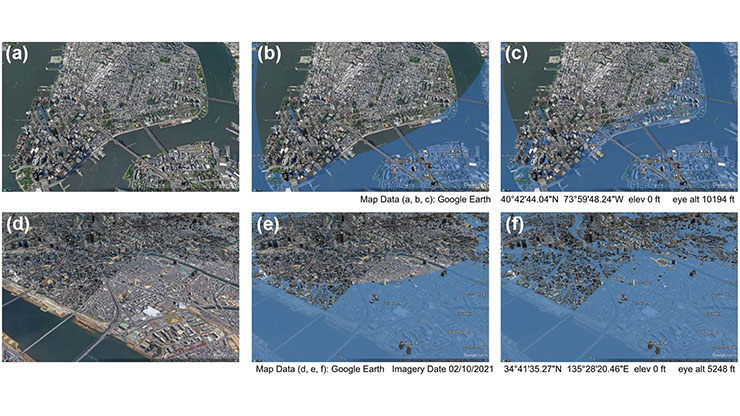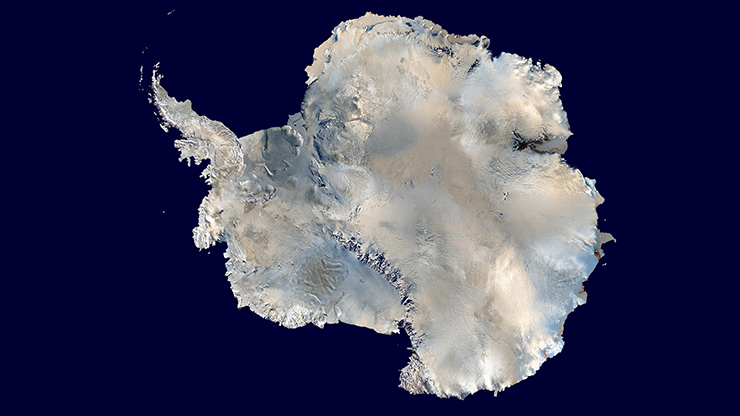A Particle-continuum Framework for Sea Ice Floe Dynamics
Sea ice plays a key role in the Arctic and global climate systems by modulating critical momentum, heat, and material transfer processes between the ocean and atmosphere. Yet despite its importance, sea ice modeling poses a formidable challenge. The phenomenon itself spans vast scales; massive ice sheets that stretch for hundreds of kilometers coexist with smaller, fragmented ice floes that drift, collide, and fracture in the marginal ice zone (MIZ), where ice meets open water. Figure 1 depicts sea ice in the Beaufort Sea off the coast of Alaska and Canada, including ice floes in the MIZ.
Traditional models treat sea ice as a continuum material or plastic, e.g., a giant deformable sheet [5]. These models work well for large-scale simulations but struggle to capture the granular, chaotic motion of individual floes. In contrast, discrete element methods (DEMs) simulate each floe as an independent particle and track collisions and rotations in detail. However, the computational cost of DEMs scales prohibitively with the number of floes — rendering large-domain or long-term simulations impractical.
To address these challenges, we recently introduced a novel multiscale modeling framework that integrates the high-resolution accuracy of DEMs for small-scale floe interactions with the computational efficiency of continuum-scale models [4]. By uniquely bridging these scales, our approach—which published in Multiscale Modeling and Simulation, an interdisciplinary SIAM journal—effectively simulates sea ice dynamics. Its broad applications range from accelerating multiscale data assimilation to improving climate predictions.
![<strong>Figure 1.</strong> A true-color image of sea ice in the Beaufort Sea from the Moderate Resolution Imaging Spectroradiometer. The image is oriented 90 degrees from standard polar stereographic coordinates so that the top is roughly north. The red box outlines the observed marginal ice zone (MIZ), and the inset on the right provides a close-up view of the MIZ on June 26, 2008; individual sea ice floes are outlined in red. Figure adapted from [1].](/media/ulmeutrq/figure1.jpg)
The Particle-continuum Multiscale Model
Our innovative framework adapts superparameterization—a powerful multiscale technique that was originally developed for atmospheric modeling—to sea ice dynamics for the first time. In atmospheric applications, superparameterization embeds high-resolution cloud-resolving models within each grid cell of a global climate model. Here, we extend this idea by instead nesting DEM simulations of individual ice floes within a continuum-scale sea ice model.
This particle-continuum implementation creates a unique two-way dialogue across scales (see Figure 2). The large-scale continuum fields provide background information and constrain the motion of each DEM component, while the fine-scale interactions between floes collectively inform the evolution of bulk ice properties. By connecting these traditionally separate modeling paradigms, we can achieve high fidelity and efficiency in the representation of sea ice’s inherently multiscale behavior. We also pursue systematic studies on the convergence behavior of this type of superparameterization technique, which provides a mathematical foundation for the modeling and computational framework.
The Particle Approach: DEM Simulations
![<strong>Figure 2.</strong> A schematic of the particle-continuum multiscale model. The model architecture couples local discrete element method (DEM) simulations (fine scale) with continuum moment equations (coarse scale). Figure adapted from [4].](/media/b4vnifxh/figure2.jpg)
DEM models simulate each floe as an independent entity. As the numerous floes interact with each other, the motion of the \(l\)th floe is governed by Newton’s laws:
\[\begin{eqnarray}\frac{\textrm{d}\mathbf{x}^l}{\textrm{d}t}&=&\mathbf{v}^l, \\ m^l\frac{\textrm{d}\mathbf{v}^1}{\textrm{d}t}&=& \sum_j(\mathbf{f}^{lj}_n+\mathbf{f}^{lj}_t)+\textrm{ocean drag}. \end{eqnarray}\]
Here, \(\mathbf{x}^l\) is the displacement, \(\mathbf{v}^l\) is the velocity, and \(\mathbf{f}^{lj}_n\) and \(\mathbf{f}^{lj}_t\) are normal and tangential contact forces between floes. We can also write a similar set of equations for the angular position and velocity. While DEM does ultimately capture collisions and rotations, the simulation of millions of floes across an ocean basin is computationally prohibitive.
Moment Equations: From DEMs to Continuum Models
To transition from DEMs to continuum models, we employ a Boltzmann equation that governs the probability distribution of floe states. Integrating this equation over the velocity/size space yields moment equations for mass, momentum, and angular momentum that constitute the continuum model; a possible extension also includes energy [3]. Statistical averages of the DEM solutions determine the stress tensor and forcing terms in these equations, creating a mathematically consistent multiscale framework with particle interactions that collectively inform continuum-scale dynamics while respecting conservation laws. For example, the mass and momentum equations are given by
\[\begin{eqnarray} \frac{\partial\langle\rho\rangle}{\partial t}+\nabla\cdot(\langle\rho\mathbf{v}\rangle)&=&0, \\ \frac{\partial\langle\rho\mathbf{v}\rangle}{\partial t}+\nabla\cdot(\langle\rho\mathbf{v}\otimes\mathbf{v}\rangle)&=&\textrm{ocean drag}. \end{eqnarray}\]
The Hybrid Model
Our novel particle-continuum multiscale model addresses the fundamental tradeoff between continuum models that lack small-scale detail and DEM models that lack large-scale efficiency. It contains the following components:
- Fine-scale local DEM simulations: All grid cells in the continuum model run an independent DEM simulation with periodic boundary conditions. The model tracks floe properties (e.g., size, velocity, and rotation) within each grid cell and facilitates the use of parallel computing in every cell, which significantly improves computational efficiency.
- Coarse-scale continuum moment equations: These equations describe the evolution of averaged physical quantities of floes over time.
- Two-way coupling: The continuum model guides the motion of each DEM component, and DEM statistics feed back into the continuum model.
Broader Impacts
As Arctic sea ice becomes increasingly fragmented, our research provides an essential toolkit for the modeling and prediction of floe dynamics in MIZ regimes — a critical capability for climate adaptation, marine navigation, and policy decisions. The paradigm-shifting multiscale framework is similarly impactful beyond sea ice applications and constitutes a unique tool for the simulation of diverse natural systems where particle and continuum physics interact, from granular avalanches to planetary ice-ocean interfaces.
This work’s mathematical foundations establish a rigorous pathway for multiscale modeling’s application to realistic scenarios. For instance, it facilitates coupling between models and advanced DEM formulations that explicitly resolve floe shape evolution and fracture dynamics [6]. The framework has already inspired additional innovations, notably serving as the basis of a novel hybrid Eulerian-Lagrangian data assimilation algorithm for fragmented sea ice [2].
By bridging particle- and continuum-scale physics, our multiscale modeling framework can resolve high-resolution, large-scale simulations that were previously intractable. Ultimately, our study paves the way for next-generation Earth system models and beyond.
References
[1] Covington, J., Chen, N., & Wilhelmus, M.M. (2022). Bridging gaps in the climate observation network: A physics-based nonlinear dynamical interpolation of Lagrangian ice floe measurements via data-driven stochastic models. J. Adv. Model. Earth Syst., 14(9), e2022MS003218.
[2] Deng, Q., Chen, N., Stechmann, S.N., & Hu, J. (2025). LEMDA: A Lagrangian-Eulerian multiscale data assimilation framework. J. Adv. Model. Earth Syst., 17(2), e2024MS004259.
[3] Deng, Q., & Ha, S.-Y. (2025). Particle, kinetic and hydrodynamic models for sea ice floes. Part I: Non-rotating floes. Preprint, arXiv:2504.21809.
[4] Deng, Q., Stechmann, S.N., & Chen, N. (2024). Particle-continuum multiscale modeling of sea ice floes. Multiscale Model. Simul., 22(1), 230-255.
[5] Hibler III, W.D. (1979). A dynamic thermodynamic sea ice model. J. Phys. Oceanogr., 9(4), 815-846.
[6] Manucharyan, G.E., & Montemuro, B.P. (2022). SubZero: A sea ice model with an explicit representation of the floe life cycle. J. Adv. Model. Earth Syst., 14(12), e2022MS003247.
About the Authors
Quanling Deng
Lecturer, Australian National University
Quanling Deng is a lecturer at the Australian National University. He is broadly interested in the fields of computational and applied mathematics.

Samuel N. Stechmann
Professor, University of Wisconsin-Madison
Samuel N. Stechmann is a professor at the University of Wisconsin-Madison. His research interests are in applied and computational mathematics.

Nan Chen
Associate professor, University of Wisconsin-Madison
Nan Chen is an associate professor at the University of Wisconsin-Madison. His work covers general applied mathematics, atmospheric and ocean science, and data science.

Related Reading
Stay Up-to-Date with Email Alerts
Sign up for our monthly newsletter and emails about other topics of your choosing.






